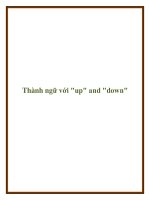falling down
Bạn đang xem bản rút gọn của tài liệu. Xem và tải ngay bản đầy đủ của tài liệu tại đây (33.13 KB, 1 trang )
The film Falling Down is about a man named Bill that loses control of his anger and frustration
when confronted with typical everyday stress. He has reached his breaking point and loses his cool
as well as his sense of self. The movie demonstrates examples of both cultural and social issues.
Cultural issues explored by this movie are the existence of subcultures and countercultures in city
life. The movie takes place in Los Angeles, California that is largely populated by Mexicans and
Oriental migrants. The protagonist, played by Michael Douglas, encounters and oriental man that
owns a local mini mart and two Mexican gang members. The oriental man represents the
subculture and the gang members represent the counterculture. The social issues are reflected
through gender relations, racial relations, and anomie, as well as traffic and violence. This film has
great emphasis on the social aspect. The film places these factors in the context of a social setting
with cultural influences.
Social stratification plays a minor role in this movie. The only valid example of it is in the scenes
involving the police officers. There is a rank system within the field of police work and the
particular ranks are respected. Gender roles play a somewhat larger role within the context of the
main character. There is a moderate amount of interaction between the protagonist and his
ex-wife. However, the communications between them is brief and tense. The ex-wife fears him
because of his uncontrollable temper. Bill, however, speaks to her under the disillusion that they
are still a family.
Race and ethnicity are important facets of the story line. The first meeting is between the
protagonist and the oriental man that owns the local mini mart. After abandoning his car in a
traffic jam. Bill goes to the payphone to call his wife. He realizes that he doesn't have enough
change and goes to the mini mart to change a dollar bill. The oriental man tells him he must make
a purchase in order to get change. He opts to buy a coca-cola. The oriental man tells him the coke
will cost him $0.85. Bill is very disturbed because this will not give him enough change to make
the phone call. He feels cheated because a foreigner is overcharging him to buy American goods.
At the end of the scene, he has his first outburst and damages many of the goods and products and
then buys the soda at a reasonable price. This scene also illustrates the main characters current
social role as a consumer. The next meeting is with the Mexican gang members who threaten him
in the name of territory. They look and communicate differently not only because they are
Hispanic, but because they have their own internal communication system within the gang
members. He uses the wooden bat that he took from the mini mart to physically defend himself
against the gang members. The scene contains his second outburst.
The film takes place in a city much like Miami. The mood in the metropolitan city is very busy,
fast-paced, defensive, and stressed. The film opens in a scene where the protagonist is "trapped" in
his car while stuck in traffic due to road construction. This is very typical of life here in Miami.
The issues raised by the film are relative to the Miami lifestyle. Many of us can relate to the
frustration we feel when stuck in traffic caused by roadwork during rush hour. We can also relate
to the volume of shops and restaurants owned by foreigners and the ever -growing concern with
inflation.
This film seems to have been designed to entertain viewers. Nevertheless, it has some key social
elements that express to the viewer about the sociology of urban life. This film encourages critical
thinking to those who are willing to study this film for its true social value. Unfortunately, most
people view this film for entertainment purposes and do not make the time to read into it. It seems
that the overall public reaction is that this movie reflects the social nor, and that it will be accepted
as such. Within that state of mind, people would see the film as a reflection of modern times and
not wonder, "What we can do about it?"









